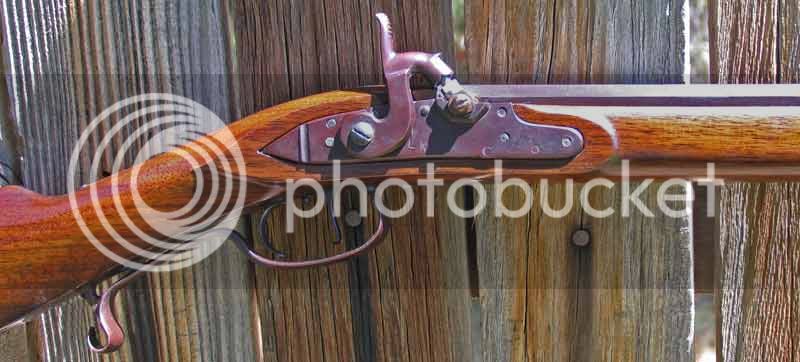OK. I can hear you now. "SACRILEGE! The guy must be out of his mind!"
I did have a good reason for modifying this Siler Flintlock kit lock into a Percussion lock though.
Back in '01, I started building this kit and after drilling and tapping all of the holes except one I clamped the frizzen in place and proceeded to drill thru.
As my lack of luck would come to the forefront, the drill was slightly cocked and it tore half of the frizzen bridle away. What to do??
This is my new Tennessee with the answer:

I plugged the un-needed holes with threaded stock and cut off the pan leaving enough to support a nipple drum, bought and installed a Siler hammer and set the lock on a shelf for some project like this Tennessee.
After installing the lock into the stock and determining the location of the drum, I filed the pan out to support it.
Normally, I would have filed the notch in the lock and then used the drum installed to position the lock in the stock but this was a Pre Carved stock with the lock inletting already done. That pretty much dictated where the drum would have to be located.
Because of the location of the mainspring under the bolster, I was limited to using a 7/16 diameter drum. Larger would have required removing so much material from the pan that the tip of the mainspring would break thru the bottom of the cut.
Notice the hammer has a number of filed "teeth" on the face of it. These were cut with a small triangular file with the upper edges roughly parallel with the barrel. I highly recommend cutting some sort of roughness and this method is much easier than trying to file a knurling pattern. I guarentee your thumb will not slip when you cock this hammer. :grin:
There are more pictures of my rifle over in the Percussion Forum if your interested.
Zonie
I did have a good reason for modifying this Siler Flintlock kit lock into a Percussion lock though.
Back in '01, I started building this kit and after drilling and tapping all of the holes except one I clamped the frizzen in place and proceeded to drill thru.
As my lack of luck would come to the forefront, the drill was slightly cocked and it tore half of the frizzen bridle away. What to do??
This is my new Tennessee with the answer:

I plugged the un-needed holes with threaded stock and cut off the pan leaving enough to support a nipple drum, bought and installed a Siler hammer and set the lock on a shelf for some project like this Tennessee.
After installing the lock into the stock and determining the location of the drum, I filed the pan out to support it.
Normally, I would have filed the notch in the lock and then used the drum installed to position the lock in the stock but this was a Pre Carved stock with the lock inletting already done. That pretty much dictated where the drum would have to be located.
Because of the location of the mainspring under the bolster, I was limited to using a 7/16 diameter drum. Larger would have required removing so much material from the pan that the tip of the mainspring would break thru the bottom of the cut.
Notice the hammer has a number of filed "teeth" on the face of it. These were cut with a small triangular file with the upper edges roughly parallel with the barrel. I highly recommend cutting some sort of roughness and this method is much easier than trying to file a knurling pattern. I guarentee your thumb will not slip when you cock this hammer. :grin:
There are more pictures of my rifle over in the Percussion Forum if your interested.
Zonie




